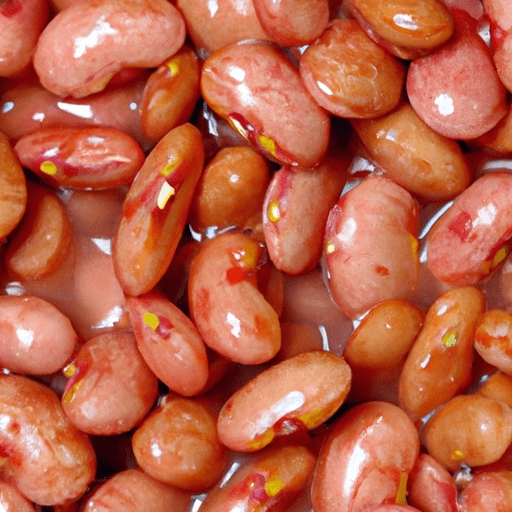The Versatile Canned Roman Beans: A Delightful Addition to Your Pantry
If you are looking for a versatile and delicious ingredient to enhance your cooking, look no further than canned Roman beans. These delightful legumes have been a staple in Mediterranean cuisine for centuries and are sure to become a favorite in your kitchen too. In this blog post, we will explore the taste, common uses, nutritional value, and interesting facts about canned Roman beans.
Taste and Texture
Canned Roman beans, also known as cranberry beans or borlotti beans, have a distinct creamy texture and a mild, nutty flavor. Their delicate taste pairs well with a variety of ingredients, making them an ideal addition to countless recipes. Whether pureed in soups, added to stews, or simply tossed in salads, canned Roman beans provide a satisfying and hearty bite.
Common Uses in Cooking
The versatility of canned Roman beans makes them a culinary gem. These legumes effortlessly blend with various cuisines, adding depth and substance to countless dishes. Here are some common ways to unleash the potential of canned Roman beans in your cooking:
1. Soups and Stews
Canned Roman beans are a go-to ingredient in hearty soups and stews. Their creamy texture and mild taste complement the rich flavors of broth and vegetables, creating a soul-warming meal. Try adding them to minestrone, chili, or traditional Tuscan ribollita for a fulfilling and nutritious bowl of warmth.
2. Salads
In salads, canned Roman beans provide a creamy contrast to fresh and crisp ingredients. Toss them with seasonal vegetables, herbs, and a tangy vinaigrette to create a satisfying and protein-packed salad that will leave you feeling energized. They also make an excellent addition to pasta salads, adding substance and flavor to every bite.
3. Purees and Dips
When pureed, canned Roman beans transform into a luscious, velvety base for dips and spreads. Combine them with olive oil, lemon juice, garlic, and herbs to create a delightful bean dip perfect for serving with toasted pita bread or crunchy vegetables. Alternatively, use them as a creamy base for sandwich spreads, adding depth and nutrition to your favorite sandwiches.
Nutritional Value
Besides their delicious taste and versatility, canned Roman beans are a nutritional powerhouse. Packed with fiber, protein, vitamins, and minerals, they offer numerous health benefits. Here are some key nutritional highlights of canned Roman beans:
Fiber:
- Helps maintain a healthy digestive system.
- Provides a feeling of fullness, aiding weight management.
- Supports heart health by reducing LDL (bad) cholesterol levels.
Protein:
- Essential for building and repairing tissues.
- Provides sustainable energy.
- Helps regulate satiety, promoting weight control.
Vitamins and Minerals:
- Rich in folate, which is vital for cell division and fetal development.
- Contains iron, which supports the production of healthy red blood cells.
- Provides magnesium, potassium, and zinc, supporting overall well-being.
Interesting History and Facts
Canned Roman beans have a fascinating history that stretches back centuries. Here are some intriguing facts about these unique legumes:
Origin: Roman beans, as the name suggests, have an ancient origin in Italy. They were brought to Italy from South America during the Columbian Exchange in the 15th century and quickly became a beloved ingredient in Italian cuisine.
Cultivation: Roman beans thrive in temperate climates and are primarily grown in Italy, the United States, and Latin American countries. The distinctive pink and cream speckled pattern on their skin makes them easily recognizable.
Popularity: In Italian cuisine, these beans have been widely used in traditional dishes like pasta e fagioli and fagioli all’uccelletto since ancient times. Their popularity has spread across the globe, with many cuisines incorporating them into various recipes.
Let the Canned Roman Beans Elevate Your Cooking! With their creamy texture, mild flavor, and versatility, canned Roman beans are a pantry staple that can transform any dish. Whether you incorporate them into soups, stews, or salads, or use them to create delightful spreads and dips, these legumes will surely enhance your culinary creations. Add some cans to your shopping list and let the vibrant history and exceptional taste of canned Roman beans take center stage in your kitchen!
Canned Roman Beans
Origin and Common Uses: Roman beans, also known as borlotti beans or cranberry beans, are native to Italy and have been cultivated there for centuries. They are popular in Italian cuisine and are commonly used in dishes such as minestrone soup, pasta dishes, and salads. Canned Roman beans are a convenient option for adding these beans to various recipes.
Nutritional Benefits: Roman beans are a good source of dietary fiber, protein, and several important minerals, including iron, potassium, and magnesium. They also provide a range of B vitamins, including folate. Additionally, beans are known for their high antioxidant content, which can help protect against various chronic diseases.
Unique Properties: The unique appearance of Roman beans distinguishes them from other common beans. They have a creamy-white or pale pink background with red markings, resembling the patterns found on cranberries. When cooked, the beans turn a light brown color and develop a creamy texture similar to that of cooked potatoes. This makes them desirable for many dishes as they add both visual appeal and a hearty texture.
Historical Significance: Roman beans have a long history dating back to ancient Rome, where they were cultivated and consumed. They were introduced to Italy by the ancient Greeks, and their cultivation spread throughout the country. Roman beans have remained an important ingredient in traditional Italian cooking, particularly in regions like Tuscany, where they are used in various dishes to this day. Additionally, these beans have gained popularity in many other cuisines worldwide due to their unique flavor and versatility.




Use the share button below if you liked it.
It makes me smile, when I see it.